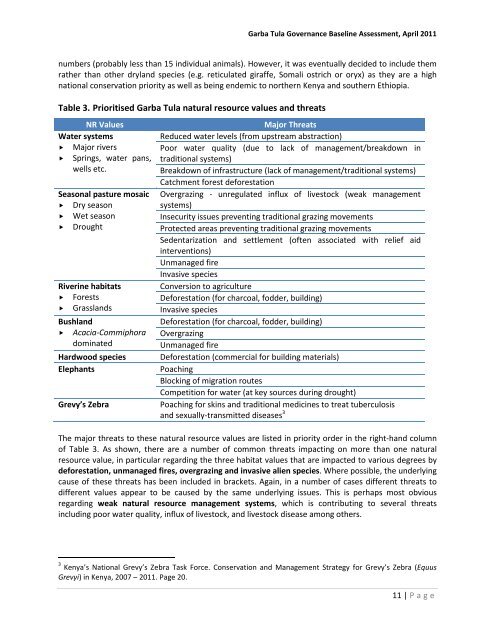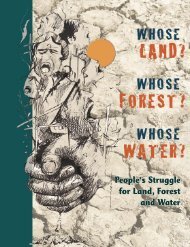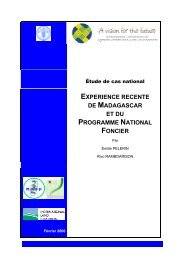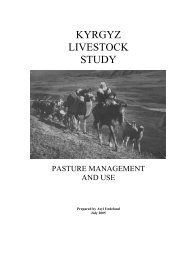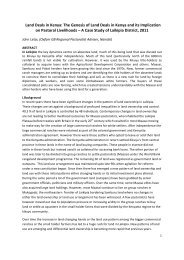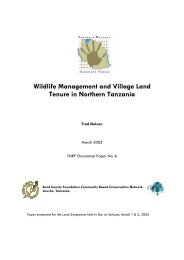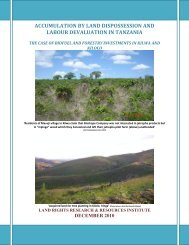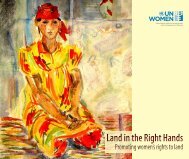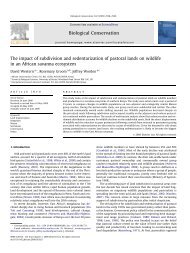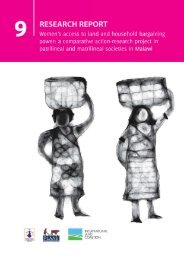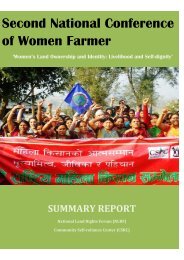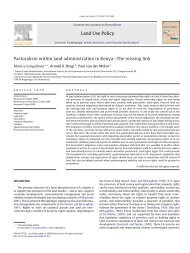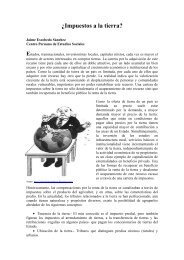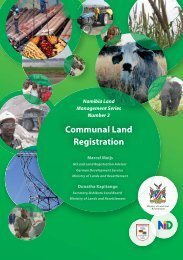Garba Tula Governance Assessment Final Report ... - Land Portal
Garba Tula Governance Assessment Final Report ... - Land Portal
Garba Tula Governance Assessment Final Report ... - Land Portal
You also want an ePaper? Increase the reach of your titles
YUMPU automatically turns print PDFs into web optimized ePapers that Google loves.
<strong>Garba</strong> <strong>Tula</strong> <strong>Governance</strong> Baseline <strong>Assessment</strong>, April 2011<br />
numbers (probably less than 15 individual animals). However, it was eventually decided to include them<br />
rather than other dryland species (e.g. reticulated giraffe, Somali ostrich or oryx) as they are a high<br />
national conservation priority as well as being endemic to northern Kenya and southern Ethiopia.<br />
Table 3. Prioritised <strong>Garba</strong> <strong>Tula</strong> natural resource values and threats<br />
NR Values Major Threats<br />
Water systems<br />
Major rivers<br />
Springs, water pans,<br />
wells etc.<br />
Seasonal pasture mosaic<br />
Dry season<br />
Wet season<br />
Drought<br />
Riverine habitats<br />
Forests<br />
Grasslands<br />
Bushland<br />
Acacia-Commiphora<br />
dominated<br />
Reduced water levels (from upstream abstraction)<br />
Poor water quality (due to lack of management/breakdown in<br />
traditional systems)<br />
Breakdown of infrastructure (lack of management/traditional systems)<br />
Catchment forest deforestation<br />
Overgrazing - unregulated influx of livestock (weak management<br />
systems)<br />
Insecurity issues preventing traditional grazing movements<br />
Protected areas preventing traditional grazing movements<br />
Sedentarization and settlement (often associated with relief aid<br />
interventions)<br />
Unmanaged fire<br />
Invasive species<br />
Conversion to agriculture<br />
Deforestation (for charcoal, fodder, building)<br />
Invasive species<br />
Deforestation (for charcoal, fodder, building)<br />
Overgrazing<br />
Unmanaged fire<br />
Hardwood species Deforestation (commercial for building materials)<br />
Elephants Poaching<br />
Blocking of migration routes<br />
Competition for water (at key sources during drought)<br />
Grevy’s Zebra Poaching for skins and traditional medicines to treat tuberculosis<br />
and sexually-transmitted diseases 3<br />
The major threats to these natural resource values are listed in priority order in the right-hand column<br />
of Table 3. As shown, there are a number of common threats impacting on more than one natural<br />
resource value, in particular regarding the three habitat values that are impacted to various degrees by<br />
deforestation, unmanaged fires, overgrazing and invasive alien species. Where possible, the underlying<br />
cause of these threats has been included in brackets. Again, in a number of cases different threats to<br />
different values appear to be caused by the same underlying issues. This is perhaps most obvious<br />
regarding weak natural resource management systems, which is contributing to several threats<br />
including poor water quality, influx of livestock, and livestock disease among others.<br />
3 Kenya’s National Grevy’s Zebra Task Force. Conservation and Management Strategy for Grevy’s Zebra (Equus<br />
Grevyi) in Kenya, 2007 – 2011. Page 20.<br />
11 | P a g e


